Brenda Knight Graham's Blog, page 2
June 11, 2025
A Day Lily’s Day

I often wish daylilies would last more than one day. The pristine blooms open before dawn and are healthy and bright all day. They don’t take naps. They don’t close up at 4 o’clock. They are not easily bruised and battered by a rainstorm. But at sundown they quietly curl into shriveled gold, just a flimsy rag of a lily no good for more than a memory.
Bright blue Nile lilies, amaryllis, cannas, and callas and costas bloom for a week or more. But not beautiful daylilies. Yet daylilies–golden ones, orange ones, burgundy, multicolored, all kinds of daylilies–are treasured for their one day’s reign as beauty queens. Our Creator, when He was on earth as a man, noted how the lilies outshone Solomon in all his glory. In only one day a single lily can brighten our garden, give us joy, make our hearts to sing.
Those who have gardens of dozens of varieties of daylilies may enjoy the stunning colors for weeks. I have seen a few of those gardens, marveled at their beauty. We, too, at our house across town, were blessed with many more daylilies than we have here. But here, our season is about over, except for the rare singles that surprise us even in September.
The daylily’s scientific name is Hemerocallis, which means “beautiful for a day.” I love the mixed yellow and burgundy, intricately marked by the Master Artist. Then there’s the solid burgundy, the tiger tawny, every color from strawberry candy to prairie blue eyes–that’s if you scroll through the daylily selections online. There are hundreds of varieties with new ones developed every year.
Of our few daylilies, my very favorite is the generous, delicately petaled golden one. Each day a new one opens to take the place of yesterday’s bloom. Each one is a gift to be treasured, if only for a day. Whether beaded with fresh raindrops like the one above, or silky and elegant in bright sunlight, each one takes its place in the garden fully confident of its importance for that day.
Consider the lilies how they grow; they toil not, they spin not; and yet I say unto you, that Solomon in all his glory was not arrayed like one of these. Luke 12:27 (KJV)
May 31, 2025
My Friend Miss Annie
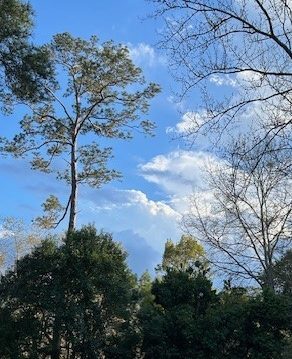
Ever since I heard she had died, I’ve had Anne Parks on my mind. I’ve known her about fifty-eight years. She’s been my sister, a mentor, a co-worker in literacy missions, but especially a friend. She changed addresses on June 26, 2025 from Old Egg Road to a mansion in heaven.
While Charles and I were picking blueberries one morning I thought about how “Miss Annie,” as I affectionately called her, loved her garden. She was so happy, too, mowing the huge yard of the home she’d grown up in and moved back to with her pastor husband. She had a lemon tree and freely distributed lemons to all her fellow literacy workers, along with recipes for using them. When her Tyus family had their annual syrup-making day she gave away bottles of the sweet stuff. Nothing made her happier than sharing Jesus with her language and music students and anyone who would stop and listen.
After picking blueberries Charles and I sat on the porch to cool. A turtle slid through our magnetic screen and proceeded to scratch his way behind plants, chairs, and swing, around and around the porch. Three times he arrived at the screen where he’d entered but could not realize that the slightest push would take him down a ramp and back to his own familiar world. Though a turtle is nothing like a dog, still I thought about Annie’s dog story she loved to tell.
After her husband, Pastor Lester, died, Annie was very lonely. Her life was full with playing organ and/or piano at her church, teaching a ladies’ Bible study, and teaching ESL every Monday night–not to mention her family, her mowing, and her garden. But she was lonely. She’s told me more than once about the dog who was an answer to her prayer.
She had agreed to tend her brother Lewis’s garden while he was sick. She could manage the hoeing and harvesting and it was just across the road. But it was so quiet between the long rows of peas and cucumbers. “Lord,” she said out loud one day, “I just need someone to talk to. I don’t even have a dog.”
Miss Annie’s face brightened with intense excitement as she continued her story. She said she had barely finished her prayer when she heard a hassling sound, looked behind her, and there was a dog lying between rows, all but smiling at her, tail wagging. “Isn’t God so good!” she would exclaim before she added that it turned out the dog belonged to a neighbor and would go back home in the afternoons so Annie didn’t even have to feed him.
When our great grandchildren came over, I thought how very much Annie loved her grandchildren, and of course her three sons and their wives. She used to tell me how she would cuddle up with the children when they were little and read book after book. As they grew, we enjoyed sharing our grandchildren’s successes and funny stories.
The last time I saw Miss Annie, just a few weeks ago, she was wearing one of the many crocheted hats she made and fairly bubbling with another story.
I will miss her so much. But I find joy in thinking how she must be soaking up the delights of heaven–talking with Jesus, walking with Lester, tending a garden maybe. I wonder if the grass ever needs mowing there.
This is the day that the Lord has made; we will rejoice and be glad in it. Psalms 118:24
May 23, 2025
The Three Sisters
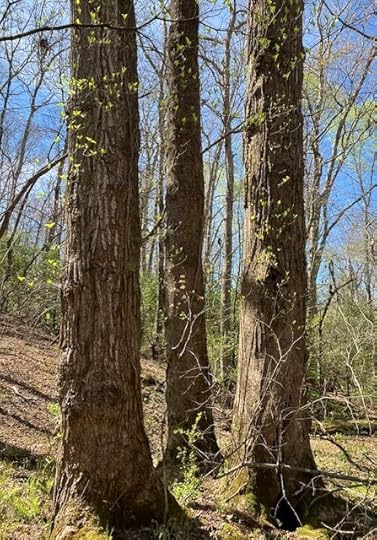
I don’t know who gave the name “The Three Sisters” to the three tulip trees standing together, tall and straight, around a small natural spring. It was probably my mother. She was so good at naming things and places.
Whoever named them, they were a central part of one of my favorite places as my siblings and I grew up. We four youngest of Mamma’s and Daddy’s ten were the main ones I remember playing there but older ones did come sometimes, especially for picnics.
Indian Spring, a few feet south of the Three Sisters, and its little companion spring we called Indian Children’s Spring had been dug by the natives sometime a hundred years or more before us. Flagstones lined the bottom of the fifteen foot circular dugout, although silt buildup kept them covered much of the time. On the upper side a constant clear trickle issued from deep in the hillside, stirring the pool with tiny ripples. One person at a time could clamor down mossy stone steps for drinking the coolest, most refreshing water in the state of Georgia. We kept a cup hung over a broken limb, but water from a hastily fashioned oak leaf cup tasted even better.
Close by the banks of Indian Spring rose a steep bluff thickly wooded with oak, pine, and a nice undergrowth of hazelnut bushes, spice bush, and sweet ferns. An old Indian trail wound along a nearby brook through thick mountain laurel and wild azalea, around the springs, and then circled the steep bluff on its way to whatever the village might have been before, in 1823, Clarkesville was established. And standing like a protective trio around the Indian Children’s Spring were those tall elegant tulip poplar trees.
The trees were like friendly sentinels keeping watch over us. In springtime they watched my sister Suzanne and me make princesses and boats with the orange and green blossoms the trees dropped. In summer they watched as my brother Charlie built a waterwheel powered by one of the brook’s little waterfalls. In fall they watched as we tumbled down the steep bluff, rustling the leaves and, on rare days, gleaning a few hazelnuts the squirrels had missed. In winter they watched as we crossed the brook either balancing on a wonderful big fallen tree or jumping from stone to stone. They watched as we picnicked, played hide and seek, hunted water lizards, and built dams with brook stones. And they listened as my brother Stanley spun such vivid tales we could all but see the Indian children playing around the springs just as we did.
Now that we’re all grandparents, some even enjoying heaven, the Three Sisters still stand there by the little Indian Children’s Spring. They haven’t changed all that much; they’re just a little stouter and bear a few more storm scars. But we’ve changed a lot! They’ve watched our children play around the springs and then our children’s children too. But often now, I think, the Three Sisters hear only the bubbling of the brook and the rustle of leaves in a breeze, the hoot of an owl at night, or the scurry of squirrels at dawn.
Do they miss us very much? Probably not. After all, they are only trees.
The picture above is by Suzanne Knight Dover.
May 8, 2025
Fox at Dusk
Once when my sister Jackie was visiting years ago we decided to go for a walk down Thirteenth Avenue to an almost forgotten old cemetery. The setting sun was in our eyes as we walked west, but when we picked our way under a canopy of trees into the graveyard, it was dusky.
We were always interested in studying old gravestones. This cemetery had WWI and WWII veterans’ graves. Several family gravestones were dated fall of 1918, probably casualties of the terrible flu epidemic. Some gravestones were toppled by tree roots, others so overgrown we couldn’t read them, especially in the dim light. The engraving on some slabs was decipherable if you studied them carefully and used your imagination. Others were cracked by large trees growing beside them, or vines wrapping around them. Some were covered with lichen.
It seemed like a forgotten cemetery. A few family names I recognized; most were unknown to me. We made up stories about some, mourned over a baby’s grave, and wondered if family members ever came to visit and remember. Only a few scattered and faded plastic flowers spoke of any attention, though there were two or three graves that were dated in the last ten years. I remembered seeing funeral processions drive past our house.
The dirt road around the little cemetery, though navigable, was overhung by oak and sweetgum. We were finding our way back to the street when we both stopped and held our breath. There, only a few feet away, was a red fox, pointed ears erect, sitting like a grave statue as if hoping we wouldn’t notice him. We watched until he stealthily slipped away, bushy tail disappearing quickly into the shadows.
It was a dark, forgotten cemetery, rich with stories. But what we talked about on our return walk was that little fox–how old he might be, where his den was, and how often he ever saw human visitors. It was nice to think that the graves were overseen by a wily red fox.
April 29, 2025
Wood Thrush Melody
I thought I heard the liquid melody of a wood thrush but I wasn’t sure I’d heard right until I saw him at the bird feeder. He looks a lot like a brown thrasher but is a little thicker and shorter, and has such a beautiful breast of brown speckles on white. The wood thrush’s song gave me a rush of well-being, a feeling of rightness, as if everything is going to be fine. I’ve listened to the world news. I know things are not okay. But the wood thrush doesn’t know it. Unlike the ostrich, he’s not hiding his head in the sand. He’s just singing in spite of all that might be wrong.
When, as a child, I heard the wood thrush in the meadow, I knew it was fully spring. There would be picnics under the mulberry tree, birds’ nests to discover, the feel of cool grass under bare feet. There would be thin new dogwood leaves to pop in one’s hands, and wild strawberries to pick.
Things are not the same, of course, now that I’m a great-grandma. But the wood thrush’s song reminds me that many good things remain, and there’s much reason for rejoicing.
My gratitude list grows quickly: God’s in His heaven and, through His Holy Spirit, is here on earth with us—As an elderly literacy student of mine used to pray, “Thank You, Lord, for the blood rushing through my veins.”—The mulberry tree is heavy with early fruit and the birds are having a feast—The purple iris are in bloom, standing erect and elegant under a Japanese maple—Friends I haven’t heard from lately responded to this blog, a sweet connection—A letter from a dear friend arrived in the mail amongst all the catalogs and political flyers—Charles and I enjoyed together cooking and eating bacon, eggs, and toast, a Saturday morning treat—
Even in sorrow, there is much reason for rejoicing. Our friend Billy Smith died last week. His memorial service was a sweet testament to the godly life he lived. We sat with other honorary pallbearers, listening with full hearts to his granddaughter, Lindsey, sing “My Tribute.” Then granddaughters Lindsey and Rebecca spoke tearfully and eloquently of this fun, loving, and faithful man. Our hearts swelled with joy at having known Billy at the same time tears flowed in sympathy for his wife Louise of 66 years. Billy had two lines in response to the question “How are you?” He would either say “Never had it so good” or “Every day’s a holiday.”
We love hearing from and seeing in person our son and his family and all our grandchildren and great-grands. William Jr. called to tell us about an upcoming mission trip and then a summer job in Memphis, Tennessee. His brother Thomas is about to graduate from Mountain Brook High School and we plan to be there. Their sister Mattie amazes us with her artistic dancing and her sweet spirit. We watched Kaison play in his final baseball game of the season and gloated with him over their win. We went to see the middle school play “Alice @ Wonderland” starring our Charli as Alice. How could grandparents of such a lively family ever be bored or depressed?
There are certainly a world of things to sing about!
About that wood thrush—I haven’t heard him again. I guess he’s gone to another neighborhood to sing his liquid melody for someone else.
April 24, 2025
Sunset Glory
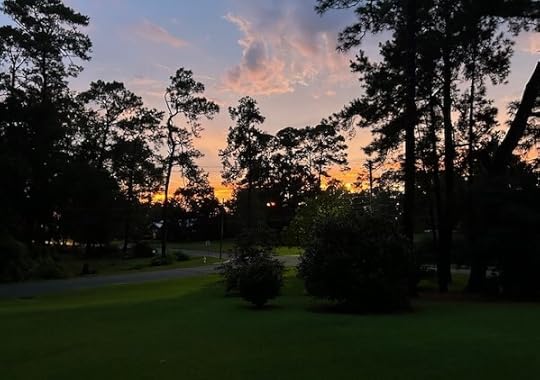
Of all the beautiful sights the Lord has given us, I think none exceeds the stunning beauty of a sunset. One of my memories from early childhood is of my dad calling all of us to the front door (aka West Door) to view a spectacular sunset punctuated with pine trees, spilling color on the distant slopes of Trey Mountain. He didn’t want anyone to miss the beauty.
When my husband and I first moved to Grady County, Georgia which borders Leon County, Florida, I missed the mountains so much. Sunsets here were beautiful, of course, but just not as breathtaking as those that turned blue mountain slopes to purple.
My mother came for a visit and exclaimed with delight over the beautiful south Georgia sunsets. I began to pay more attention to the vivid colors of the sunsets, the rich varying pinks and gold and purple and even green. Whether punctuated by pine and hemlock or by live oak and magnolia, sunsets are glorious.
Charles and I find it fun to call each other to observe an especially wonderful sunset. Charles likes to say “Look there! God is showing out tonight!”
I’ve seen a sunset at Grand Canyon, at Niagara Falls, on the wide open prairie of Saskatchewan, at Windsor Castle on a cold November eve, and on a Gulf beach where the sky is endless and the water reflects the colors no artist can quite achieve. But truly none are more beautiful than some we see right here from our mailbox or from the front porch.
I enjoy pictures of sunsets many of you, like Myra Easom, have posted on Facebook, some that, for no better description, are “unbelievable.” The pictures sent by our son Will, grandson William Jr. and others are always exciting. They are sometimes so beautiful they make me hurt. When you think about it, why does God give us such beauty? Who but He could have dreamed up all the colors of a sunset, whether in the mountains, the sea, or south Georgia.
April 18, 2025
Surprise!
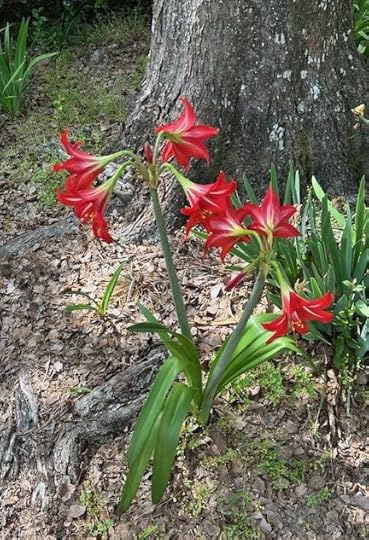
I do love surprises. Like what happened a few weeks ago. It was a normal evening for the two of us, our children and grandchildren all busy with their various school and work endeavors elsewhere, whether in Birmingham, Auburn, Tallahassee, or across town in Cairo. As I scrubbed a potato at the kitchen sink I said a prayer for Will’s safety. We’d talked that afternoon as he traveled home to Birmingham from a business conference in Gatlinburg.
I heard a slight tap on the kitchen window. I looked up thinking the cat had jumped up on the windowsill. But no! There was Will smiling so big! I thought he was hundreds of miles away but here he was at my window! I screamed with excitement, of course, and called Charles who was just as surprised as I. We all ended up in a big laughing hug. Will had decided mid-journey to come this way instead of to Birmingham and kept it a secret just for fun.
Now it’s Easter week and I’m thinking about the biggest surprise there ever was, bigger by far than anything we could imagine, bigger than the surprise that night in Bethlehem, although that was huge.
It had been a week of great joy and unimaginable sorrow for Jesus’ followers. His many followers, or sometimes just the twelve disciples, were with Him all the way from the exuberance of Palm Sunday to the astonishing cleansing of the temple to the preparation for Passover and then all the strange and wonderful events of Thursday night. I think the disciples must have finally realized something horrible was about to happen when, in the Garden of Gethsemane, Judas came bringing Roman soldiers to arrest Jesus. But they could not comprehend all that would happen in the next twenty-four hours.
Of Jesus’ followers, only a few faithful women, including Jesus’ mother, and John, the beloved disciple, were brave enough and strong enough to watch the entire crucifixion. I’ve seen the Passion of Christ and had to close my eyes to some of Christ’s humiliation and suffering. I just couldn’t bear it. But Jesus did bear it, every thorn prick, every spit, every yell of hate, every single nail, and the separation from God the Father. Think how those who were there for Him that day must have felt. Think how Jesus’ own mother felt. The grief we bear over losing loved ones, the pain we suffer from disease and accidents, none even begins to match the agony of those who watched the Son of God take on the sin of the whole world.
The women watched Jesus’ burial. So sorrowful and devastated they were, they must not have been able to talk much, except to make a plan for honoring Jesus’ body as soon as the Sabbath was over.
On the third day, very early in the morning, some of the women approached the tomb with spices to put on Jesus’ body. How would they get in the tomb with that big stone closing it? What about the Roman soldiers standing guard? And, most of all, how could they bear to see Jesus lying still and cold? Yet they were determined. It was something they had to do, no matter how hard.
Then came the Surprise, the Surprise of surprises! The stone was rolled away. The tomb was empty. Two men in white asked who they were looking for. Jesus, one man said, was risen just as He said He would be. At first the women could not understand. Where had someone taken their Lord? Then Mary Magdalene saw Jesus Himself. Though her unbelief was such that she couldn’t immediately recognize Him, when she heard His voice she knew Him. When He told her to tell the others, she ran to obey. She must have been out of breath as she told the disciples the Great Good News, that Jesus was alive.
Jesus was alive! Jesus is alive! Hallelujah! Surprise of all surprises! Though prophesied through the ages, it was still a Surprise.
“Don’t be alarmed,” he (a young man in white) said. “You are looking for Jesus the Nazarene, who was crucified. He has risen! He is not here. See the place where they laid him.” Mark 16:6
April 11, 2025
Picture of Joy
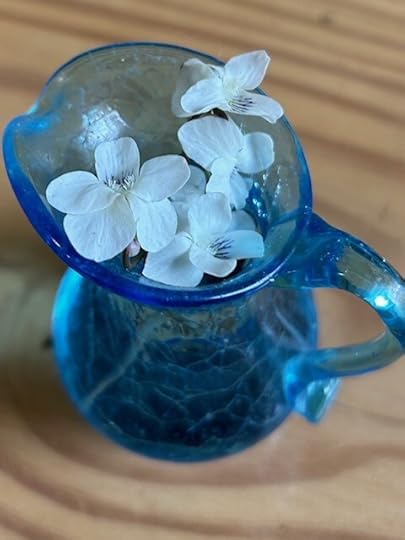
What might you use as an illustration of joy? A family reunion? A graduate with diploma in hand? A newborn baby? A boy with a fish dangling on his line? Or something as simple as a tiny nosegay of violets in a blue West Virginia glass pitcher?
In spite of evil, pain, darkness and despair, there is so much joy in this world. You can even find it illustrated in a television commercial.
A St. Jude Children’s Hospital ad gets my attention every time it comes on. A little girl, about three years old, stands with her back to the camera. Backpack on her shoulders, she’s obviously waiting, watching the driveway of her home. Her mother speaks from behind the camera. “He’s turning in the driveway. Here he comes!”
The little girl takes off running calling out with such joy, “Daddy! Daddy! We missed you! Daddy!” She leaps into her father’s arms snuggling into his embrace.
The next frame shows this little girl wriggling in her Daddy’s lap and reaching out with a small toy to interact with Mommy as well. Daddy says fondly and passionately something like, “We want our little girl to grow up happy and healthy, and always know her Mommy and Daddy love her.”
Of course the point is the need for donations to St. Jude’s to help this little girl and other young cancer patients survive. But what the ad brings to my mind every time is a picture of a helpless sinner, like me, running joyfully into the arms of Jesus.
If only we could express the same pure joy as that of the little St. Jude’s girl.
Thou wilt show me the path of life: in thy presence is fullness of joy; at thy right hand are pleasures forevermore. Psalms 16:11 (KJV)
April 3, 2025
Flight of the Bumblebee
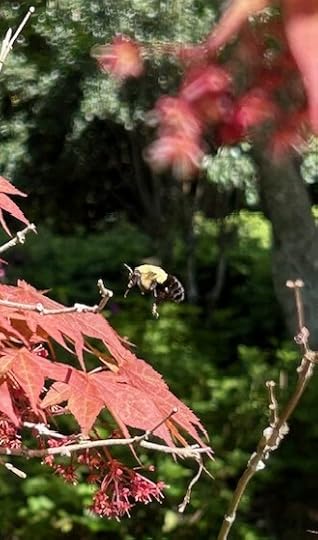
I am pretty proud of this picture taken on my iphone with a shaky hand from my walker. You can see the bee’s intriguing proboscis, the fuzz on its bumbling body, its legs that vibrate to extract pollen. As Will and I looked at the picture, we were reminded of Rimsky-Korsakov’s composition, “Flight of the Bumblebee.”
Why would Rimsky-Korsakov compose music featuring a bumblebee? “Flight of the Bumblebee” is a small part of the opera “The Tale of Tsar Saltan.” It is an interlude with no words but probably the most famous part of that opera. The opera, based on a fairytale by Aleksandr Pushkin, involves an eavesdropper disguised as a bumblebee. So I guess we’d have to consult with Pushkin to learn what inspired him to use a bumblebee, as well as a mosquito and a squirrel, in his fairytale. I think Rimsky-Korsakov was fascinated with the possibilities of using instruments to represent all those creatures. Violins, flutes, and even trumpets have played the frantic, buzzing music that really sounds like a buzzing bumblebee, yet is incredibly beautiful music. I do wonder if Rimsky-Korsakov made himself dizzy writing those thousands of fast little black notes to be played by instrumentalists.
Back to the bumblebee who has no fuzzy idea that his ancestor was in a fairytale or an opera. Here are a few interesting facts. Bumblebees have five eyes. I’m not approaching close enough to see all those eyes! They are not aggressive creatures so they don’t sting unless disturbed, such as by someone’s digging in their ground nest, or getting too close. They are fatter than honey bees and much more colorful. They don’t look as if they were made to fly, but they do fly, usually short distances near their nest but some have been known to fly as far as ten to eighty kilometers. Though they don’t make anything delightful like honey, they are good pollinators.
Some people have gotten close enough to bumblebees to learn that the queens live for about a year, long enough to start a new colony before they turn toes up. The workers, however, live only a few weeks to a month. They have to fulfill their life’s calling in a hurry!
The bumblebee whose picture I snapped was hovering like a helicopter over a subtle bloom of a Japanese maple. If I were a bumblebee I think I would have chosen to seek sweet nectar from the beautiful lavender wisteria blooms draped in several trees like Caleb’s grape clusters. But if he’d been up there I wouldn’t have had such a good look at him.
I’m blessed by my encounter with a bumblebee and by the music and story his forefathers inspired. And now I’m turning on YouTube to hear once again “Flight of the Bumblebee.”
March 26, 2025
Tuning Up
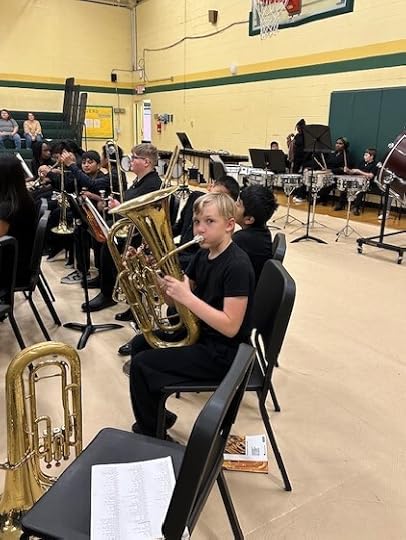
We were so proud of our great grandson, first-year band student, Kaison Evans, at a recent concert. Being somewhat handicapped grandparents, we went early and thus got in on the tuning up. Two bands were playing that day, the sixth graders and the middle school jazz band. The band director was back and forth in the gym listening to individuals, giving instructions. The noise was discordant, almost earsplitting. But the cacophony of sound was sweet in a way, reminding me of years back when it was our son tuning up, or our granddaughter, this student’s mother.
The blaring horns, trombones making their sliding notes, clarinets and flutes hitting high notes, and tubas sounding like bull frogs–how could this raucous clash of notes ever be disciplined into a pleasing sound?
When there was a pause, we waved to our grandson who, thankfully, looked pleased to see us. He plays the baritone, a deepthroated instrument, a large one for his sixth grade size. He gave us a thumbs up and grinned.
When it was time, and when all parents and grandparents were seated on bleachers, the director called out a command. There was a rattle of chairs, and suddenly all those students who had been distracted and disorderly, now sat up straight and, at a lift of the director’s hands, brought instruments to lips. At his direction the music began. Yes, it was no longer raucous clashing sound, it was music. Though tunes had different names, we recognized “Mary Had a Little Lamb,” “London Bridge is Falling Down,” “Hot Cross Buns” and others.
The tuning up had paid off.
Sometimes we all need to take time to tune up. Early in the morning while the birds are tuning up and going into concert mode, we can open our Bibles and pray to the Greatest Band Director to make us ready for the day’s music.
And David and all Israel played before God with all their might, and with singing, and with harps, and with psalteries, and with timbrels, and with cymbals, and with trumpets. I Chronicles 13:8
Brenda Knight Graham's Blog
- Brenda Knight Graham's profile
- 1 follower



